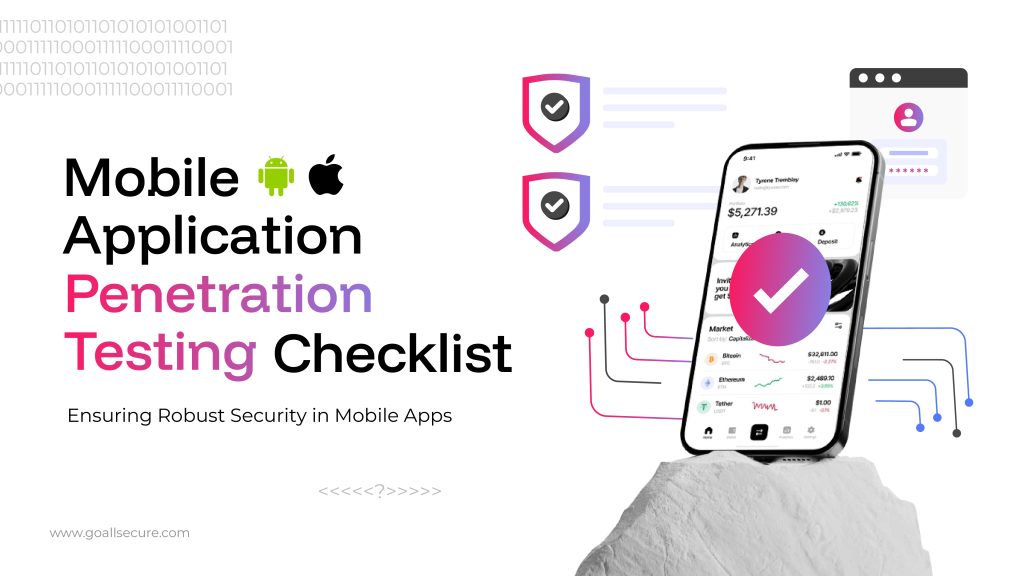The digital transformation brought about by mobile application growth allows users to access services like banking, e-commerce options, healthcare and entertainment needs. The convenience of mobile applications also exposes users to higher risks from cyber threats that specifically target mobile application systems. A wide range of security vulnerabilities reveal sensitive data and violate user privacy while causing financial losses and reputational damages. Therefore, it is clear that mobile applications face essential security threats in the digital domain which require serious attention.
Mobile application penetration testing (pen testing) represents a necessary tool to fight against these security dangers. Testing that model’s cyberattacks enables the identification of pitfalls which attackers could exploit before them. This blog delivers a thorough mobile application penetration testing checklist that merges creative solutions with security technical knowledge to develop secure mobile applications.
Prominent Security Threats in Mobile Applications
Mobile apps are a way of life for most of us. Therefore, it is critical to protect these apps against any flaws that fraudsters can exploit. The first step in doing so is understanding the numerous vulnerabilities that mobile apps face, such as unsafe data storage, insufficient input validation, and insecure communication, which allows you to prioritise security measures during development. Here is a list of the most prominent threats faced by mobile applications:
1. Insecure Data Storage – The Silent Leaker
Mobile applications expose users to unauthorised access due to their improper storage of sensitive user data. When encryption standards are weak, key administration methods fail, and local databases remain unprotected. Mobile applications risk leaking personal as well as financial data that users have stored.
2. Insufficient Authentication and Authorisation – The Open Gate
Mobile apps become vulnerable to unauthorised access because they use weak authentication methods, especially when MFA is absent and session management is done improperly. User accounts become vulnerable to attacks because of unsound authentication procedures.
3. Insecure Communication – The Eavesdropper’s Paradise
Mobile applications need secured communication between servers through APIs so attackers cannot intercept or alter sensitive information when transmission lacks encryption. The failure to use secure SSL/TLS protocols properly or to require HTTPS protection in all mobile application endpoints creates opportunities for man-in-the-middle (MitM) attacks.
4. The API backdoor – An Open Access Point
APIs create the connection network between applications running on mobile devices and server-based programs. Attackers use weak authentication along with improper input validation and excessive data exposure to make APIs easy targets, which leads to unapproved data access and functionality control alteration.
6. Insecure Code Practices – A Simple Way In
These are the security threats which stem from improper software development methods. Organisations expose security flaws that attackers can use when developers fail to implement proper coding practices, including storing hard-coded credentials and applying insufficient encryption. Security measures for encoded data must be ensured to decrease potential safety holes.
7. Lack of Binary Protections – The Modification Gateway
With no binary protection in place, attackers gain access to modify application behaviour and introduce malicious code components as well as disable security measures within the software. Unauthorised activities and credential theft alongside unauthorised access to premium features with no payment become possible because of this vulnerability.
8. Weak Cryptography – The Broken Shield
The implementation of weak insecure cryptographic algorithms within mobile applications permits attackers to launch brute-force attacks as well as detection attempts that succeed in decrypting sensitive data. Secure encryption should be implemented to protect all sensitive information.
9. Insufficient Logging and Monitoring – The Invisible Attack
Security breaches remain unseen because organisations fail to track and monitor their applications properly. Attackers use hidden methods to modify mobile applications and APIs which stay undetected until they damage systems extensively before anyone notices.
10. Unsecured Third-Party Libraries – The Trojan Horse
Mobile applications using third-party libraries as well as SDKs create security vulnerabilities since these components remain exposed when they skip regular updates or fail to pass proper security checks. An evaluation of these components should take place before they develop into security attack entry points.
The Ultimate Penetration Testing Checklist for Your Mobile Applications
App developers working with security teams must implement a structured method of penetration testing to enhance mobile application protection against increasing threats. The following detailed guide touches on all fundamental security concerns:
1. Define Testing Scope
- Your testing scope must be defined before conducting an engagement preparation phase.
- Designate the testing platforms between Android and iOS in addition to hybrid systems.
- Obtain necessary details related to the mobile application, including its API specifications alongside authentication methods and storage procedures.
- The testing method should be determined through selection between black-box, white-box and grey-box testing approaches.
- Submit all requests to perform a penetration test for authorisation from necessary administrative entities.
2. Static Application Security Testing (SAST)
- The application needs decompiling to examine its source code for any embedded credentials or API keys.
- Examine all systems that store sensitive data in unencrypted plain text files as well as databases and shared preferences.
- It is important to verify if any system resources receive access permission settings beyond necessary requirements.
- Security experts should evaluate cryptographic methodology to verify the proper implementation of strong encryption algorithms.
- Check for obsolete as well as insecure third-party library components.
3. Dynamic Application Security Testing (DAST)
- The application needs analysis of its operational behaviour during true attack situations.
- Security professionals should perform HTTP/HTTPS traffic monitoring through Burp Suite or ZAP.
- Dynamically test all API endpoints together with their authentication protocols to identify possible cases of insecure configuration.
- Duplicate this section to examine input validation methods that should block SQL injection compromises alongside other vulnerabilities such as XSS and command injection attacks.
- Conduct tests which would reveal how attacks such as session hijacking along with privilege escalation attempts behave within the system.
4. Network and Communication Security Testing
- Every data transmission needs to employ strong TLS encryption through HTTPS protocol.
- Evaluation of possible Man-in-the-Middle (MitM) attacks should happen through the use of proxy tools.
- Execute tests to confirm that the SSL certificate pinning framework operates correctly to stop SSL spoofing attacks.
- Research teams must conduct scans of network data for released sensitive information in both logs and debug outputs.
5. API Security Testing
- Requests to the API need authentication protocols that stop unauthorised system entry.
- Register various rate-limiting solutions to block unauthorised brute-force attacks.
- Test the correct implementation of OAuth together with JWT and token-based authentication methods.
- An investigation should be conducted on API error handling to stop unauthorised information exposure.
6. Reverse Engineering and Code Obfuscation Testing
- Reverse engineering tools should be used to attempt decompiling the mobile application.
- A complete evaluation of extracted source code must identify all potential security vulnerabilities within its structure.
- The test evaluates security methods which aim to hide important coding sections.
- Tests should check output logs to verify that operational details and required data do not get displayed under any circumstances.
7. Binary Modification and Tampering
- The examination evaluates changes in application binary files which take place without proper authorisation.
- Users attempt to overcome application security measures through modifications of the application execution.
- Research the systems that protect against unauthorised repackaging activities and procedures of distribution.
8. Data Storage and Cryptography Testing
- Testing requirements should confirm that confidential data encryption covers all storage situations to prevent clear text data exposure.
- Test for improper encryption implementation.
- Evaluation of encryption keys as well as their methods to ensure proper exposure and encryption strength.
- Proper configuration must be verified for every authenticated mechanism which uses biological data.
9. Session Management and Authentication Testing
- The system needs to manage two essential security functions: test session expiration measures and test session fixation protection.
- Analyse multi-factor authentication implementation.
- Determine if password guidelines match organisational standards and ensure proper passwordisation lockout functions work.
10. Post-Testing Remediation and Reporting
- Write down all vulnerabilities that surface from testing, then sync them with proper risk evaluations.
- Present additional security strategies for addressing security weakness points.
- Testing should take place once again after recognising security fixes to verify that fixes have succeeded.
Conclusion: Strengthening Mobile App Security for a Safer Future
The modern security threats within the cyber domain require organisations to adopt immediate measures for protecting mobile applications. Penetration testing provides businesses with full visibility to identify security vulnerabilities, which helps them prevent successful attacks from happening. A complete defence strategy emerges from using static analysis with dynamic testing to perform reverse engineering assessments and execute network security evaluations on a planned framework. When security best practices become part of the mobile application development process and security protocols receive ongoing updates, businesses ensure safe user data and improve trust while remaining compliant with industry standards. Mobile security will advance through continuous testing along with adaptive defence mechanisms and organisations’ commitment to cybersecurity excellence.
Today, security has evolved into an absolute requirement, and GoAllSecure provides you with all the cyber defence you need. We protect your mobile apps against emerging cyber threats. We employ comprehensive protection at every stage of the threat lifecycle. Do you need assistance enhancing the security of your mobile application? Contact GoAllSecure at +91 85 2723 7851 or +44 20 3287 4253 to learn more about our mobile application penetration testing services.

















 TRAVEL & HOSPITALITY
TRAVEL & HOSPITALITY HEALTHCARE
HEALTHCARE RETAILS & ECOMMERCE
RETAILS & ECOMMERCE BANKING & FINANCIAL
BANKING & FINANCIAL AutoMobile
AutoMobile MANUFACTURING
MANUFACTURING FOOD
FOOD EDUCATION
EDUCATION



